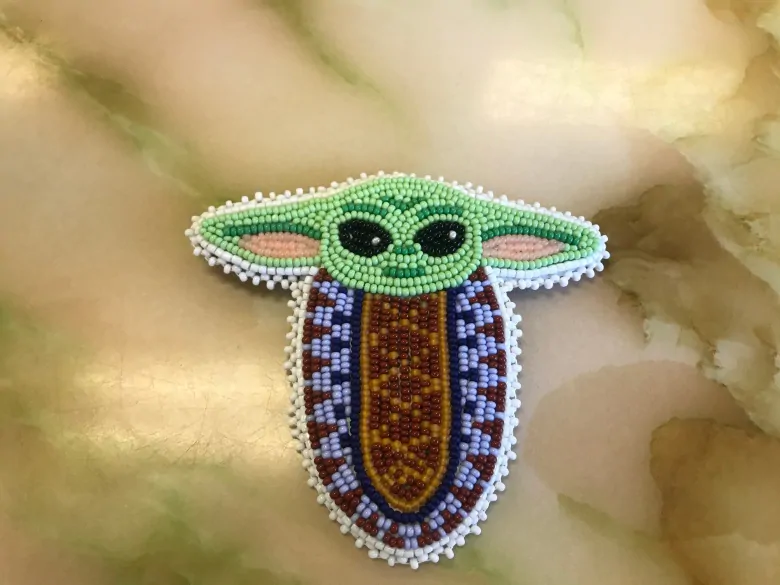Why some Indigenous people see themselves in Star Wars icon Baby Yoda

If you’ve been on social media lately, chances are you’ve come across a cute green creature.
Baby Yoda — or “the child” in the Star Wars web series The Mandalorian — has stolen hearts across the internet. And Indigenous fans in particular are claiming the adorable alien as one of their own in everything from memes and jewlery to artwork and clothing.
In Yellowknife, Melaw Nakhek’o, a Dene artist, actress, moosehide tanner and co-founder of Dene Nahjo, recently beaded Baby Yoda in a moss basket.
“He’s just so cute,” she gushed.
Nakhek’o said the piece was a hit at a holiday gift exchange. It’s based on a design created by Cree/Abenaki two-spirit artist Nalakwsis which was posted on Instagram as part of a beading challenge.
“I grew up watching Star Wars,” Nakhek’o said. “I often imagined my grandparents were like Jedi masters and teaching me the way of the force which was kind of like our Dene way of doing things.”
She explained she sees similarities between the force, an energy field created by life in the Star Wars universe, and the Dene philosophy of being one with the land, plants and animals.
‘We see a lot of those same struggles’
Johnnie Jae, who is from the Otoe-Missoria and Choctaw tribes, said she loves seeing Indigenous interpretations of Baby Yoda. She’s the founder of A Tribe Called Geek, a media platform that celebrates Indigenous STEM and geek culture.
“I don’t know how it’s possible that they made something so cute that people are literally losing their minds over,” she said of Baby Yoda. “To see that being incorporated into Native pop culture is amazing.”

Jae said the character resonates with so many Indigenous people because his story shares similarities with colonization, and the residential school and child welfare systems.
In The Mandalorian, Baby Yoda is sought by bounty hunters that try to kill him or capture him to exploit his knowledge and power. Many fans believe Baby Yoda may be the last living member of his kind.
“We see a lot of those same struggles within our own communities,” Jae said.
“Native children have been targeted and trafficked by for-profit adoption industries, been adopted out to non-Native families, and that really severs that connection to who we are as Indigenous people.”
Simon Moya-Smith, an Oglala Lakota and Chicano writer and journalist, also sees parallels between Indigenous youth and the new Star Wars character.
“I think we see ourselves in Baby Yoda as the young, little, budding, eager Native at powwows and rallies and marches and ceremonies,” he told CBC. “We’re that kid looking at our elders and looking at our family all around us learning, absorbing.”
Claiming space
Moya-Smith recently wrote about Baby Yoda being Indigenous for NBC. He said it was his editor, who is not Indigenous, that approached him about the story, which shows the impact the Indigenous community can have online.
“I think people are starting to realize that they cannot continue to ignore Indigenous people especially in our hyper-social media age,” he said.
Traditionally in nerd culture, Jae said Indigenous representation has been lacking or based on racist stereotypes. But that’s starting to change as more Indigenous people have been telling their own stories and Indigenizing mainstream pop culture.
“We’re able to kind of claim a space for ourselves within these different fandoms,” she said.

“I think it’s really empowering to see that because I grew up a Star Wars geek, I was always kind of a weird little kid and I never really felt like I belonged.”
Moya-Smith said it’s especially important for Indigenous youth to see themselves represented in media and to know that they can be writers and graphic designers among other opportunities.
“I think it’s important that Indigenous people continue to share all of these creative things that Indigenous people do,” he said. “Legacy media is not always going to knock at the door and ask for a story on it, we need to do it ourselves so they cannot ignore us.”





